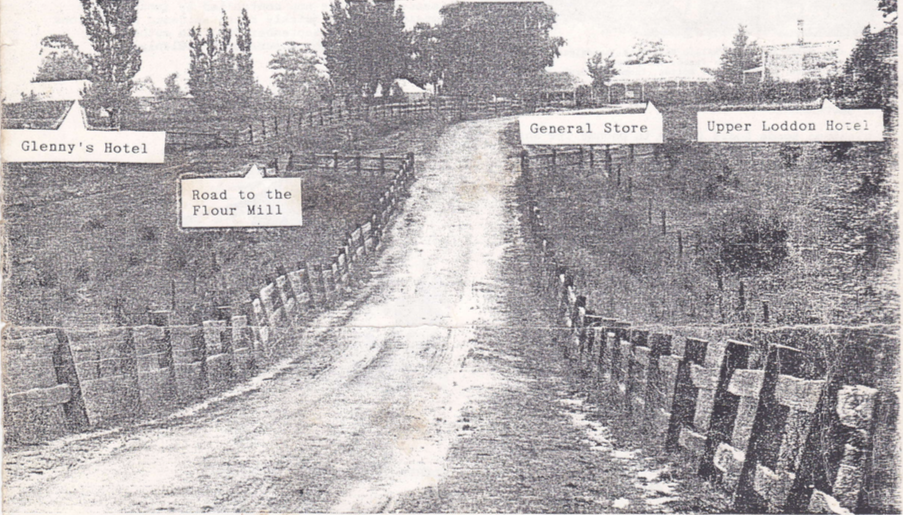
A Brief History of the Glenlyon Shire Hall
For years there had been complaints about the dilapidated and draughty old slab sided hut that served as the old Shire Hall. The gentlemen of the Daylesford press, who reported the sometimes long-winded debates of the Glenlyon Council meetings, were forever complaining of the cold winds that blew through the cracks in the wall near the press table. On the first and third Wednesday of the month this ramshackle hovel also became a “Court of the Midland Bailiwick of the Colony of Victoria”.
The District police Magistrate, Mr John J O’Meara, suffered badly from rheumatics and told the council, “Unless this building is made weatherproof, I will transfer district court hearings to Daylesford”.
This threat to prestige was enough to finally bring action. At the monthly council meeting on the 17th February 1890, Shire President Cr David Scott, reported to his fellow councillors, “As Chairman of the Hall Building Committee, I wish to put before you for consideration this plan for a new hall building prepared by Gilbert and Clegg, the architects of Ballarat”.
Reproduced from the “Back to Glenlyon Centenary of the Shire Hall souvenir brochure of 1991”
This plan was approved and the estimated cost was 400 pounds, but this estimate did not include the cost of stabling for the councillors’ horses, fencing or the cost of replacing the battered old furniture. ?The real cost may be as high as 500 or 550 pounds”, Cr Scott said. “I don’t think we can spare any money for a hall”, said Cr John Lavery of North Drummond. “ We need more money than we can raise now to carry out urgent public works.”
Cr John Dyer of the Western Riding agreed with these sentiments and seconded Cr Lavery’s remarks.
But then Cr James Henry Wheeler, MLA, J, rose to his feet to address the council. Cr Wheeler was a wealthy and influential businessman and a politician. He suggested that a loan should be taken out and informed the council that the Daylesford loan of 600 pounds to build their hall cost them only 23 pounds to float.
At the April meeting of the council it was moved and carried “that council float a loan for 650 pounds in 13 debentures of 50 pounds each to pay interest at 6 pounds per annum for the purpose of building a new Shire Hall, Offices and Stabling at Glenlyon.”
Shire President Cr David Scott was well pleased with progress and the next step was to advertise for tenders from builders to erect the building. But at that time there were more pressing matters - council elections. Most sitting members were returned but a 28-year old farmer named James Bolton replaced Cr John Dyer of Western Riding and Cr Thomas Tully Order became Shire President and Chairman of the Hall Building Committee in place of Cr David Scott.
The new Shire President Cr Thomas Tully Orde was a wealthy and successful self-made business man. He had established both “The Upper Loddon Hotel”, and the General Store and was an original member of the Glenlyon Road Board when it was formed in 1860. However, in 1890 he was engaged in operating two large and successful sawmills in partnership with James McMillan.
Cr Orde was also used to getting his own way and in the past had had several confrontations with other members of the council. On at least two occasions written notices had been sent to him by the council. Once over his felling roadside trees for his mills without council approval and again for continuing to graze his sheep on the town common after permission had been refused.
Meanwhile, in September notices had appeared in Daylesford, Ballarat and Melbourne papers advertising tenders for erection of a new Shire Hall at Glenlyon. Eight replies had been received and the lowest tender of 565 pounds by Martin and Chandler of South Yarra was accepted and the builders instructed to start work.
The Shire Secretary, Mr Stephen Langley, was in overall charge of the project but it fell to Mr Phillip Mauger to be responsible for the day to day supervision of the site.
The first indication that perhaps things were not quite right came when the builders announced they were having difficulties in understanding the architect’s plans and specifications. Phillip Mauger could not understand them either.
The builders were obtaining their timber from Orde’s sawmill and some Councillors believed that some of the timber delivered to the site was in short lengths and of poor quality and should have been rejected.
There were too many opportunities for things to go wrong. Cr Orde was now the Shire President and Chairman of the Hall Building Committee and also the main supplier of materials to the building contractor. The builders were a Melbourne firm. They could not understand the plans drawn by a Ballarat firm of architects and Phillip Mauger was inexperienced and did not know what was required in supervising a building construction. There was bound to be trouble.
Reproduced from the “Back to Glenlyon Centenary of the Shire Hall souvenir brochure of 1991”
